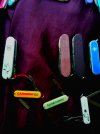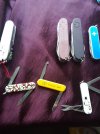I built my own copy of the rare 2 layer Scientist. It's the smallest 91mm knife with a corkscrew and a Phillips. Factory made versions of this SAK sell for hundreds of dollars. I ordered some brand new scales to put on it and they just recently arrived.
Here's a close-up shot of the small gap that I created in order to solve the common problem of the inline Phillips driver striking the sideplate.
I made this alox Rambler from an alox Classic SD and a celidor Jetsetter. The liner in the middle was a leftover piece from an old Minichamp that I disassembled a while ago. The pivots were cut from fresh stock of USA made K&S #9862 1.5mm brass rod. Check out those lovely rivets. I think I'm getting pretty decent at peening and I've even discovered a few neat little tricks.
The autofocus would not cooperate when I was taking this picture. This is a knifeless build. It has two different versions of the metal file/saw. The first layer has an older style hardened fine file/saw with a combo can/bottle opener tool, and the second layer has a newer style coarse file/saw. The back tools are a Phillips head screwdriver and a small flat head "dolphin" screwdriver.
I named it the
Urbanite because I think it sounds cool.

You should theoretically be able to take it anywhere because it has no sharp edges.
Here is a close-up of the layers. The SAK is temporarily fitted with test scales, so please ignore the spaces between the scales and the sideplates. The test scales are worn out from being added and removed from different SAKs too many times. Now they won't remain flush anymore unless you hold them down with your fingers.
The tolerances on this build are super tight. The liner and the spacer next to the combo tool both had to be filed down to allow the metal file to close all the way down where it should be. The file sits right on top of them. The metal file is also longer than the main blade that it is replacing, so the tip almost pokes over into the layer next to it. A small washer also had to be added between the file and the sideplate, since the file is thinner than the main blade.
When I tested this configuration, everything seemed to be working fine, so I cut the brass rods and began peening them. After both of the side pivots were peened, the file stopped closing properly. The file kept trying to close down on top of the combo tool. At this point I thought maybe the build was a failure, but I kept going anyway on a hunch. Sure enough, after the back tools pivot was fully peened, the problem resolved itself and the file began closing properly again. These custom SAK builds can sometimes be extremely fiddly. I think what happened was that the back pivot being tightened down pulled the sideplates tighter on the bottom, which made them open up a little on the top, which in turn took just the right amount of pressure off of the combo tool to keep it out of the path of the file. That's my theory and I'm sticking to it.

Also


.















